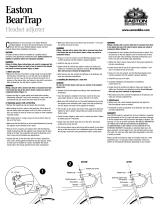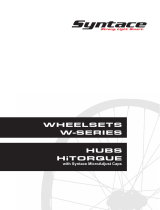Page is loading ...

© Copyright Trek Bicycle Corporation 2004
All rights reserved
BONTRAGER ROAD FORK OWNER'S MANUAL
For: Bontrager Race XXX Lite
Bontrager Race X Lite
Bontrager Race Lite
Bontrager Race
Bontrager Satellite (2 models; standard or long-reach, 57mm calipers)
Bontrager Satellite (for cantilever or V-type brakes)
Part Number 25?
Table of contents
Read this manual before you ride
...............................................................
..
1
Consider before installing
...............................................................
..............
2
Inspect your fork before each ride
...............................................................
.
2
Re-alignment of the fork is not possible
.......................................................
3
To maintain the fork, keep it clean
...............................................................
3
Do not modify the fork in any way
...............................................................
3
Fork repair is done at the factory
...............................................................
..
3
Installation instructions for the experienced mechanic
............................
4-5
Bontrager warranty
...............................................................
........................
6
Please read this instruction manual thoroughly before using your new fork; it
contains important safety and maintenance information.
If you do not understand the information in this manual, or you have
a question about your fork that this manual does not cover, consult your
Bontrager dealer. If you have a question or problem that your Bontrager dealer
can’t handle, contact us at:
Bontrager Components
920.478.4678
Attn: Customer Service
http://www.bontrager.com
801 W. Madison Street
Waterloo, Wisconsin 53594
READ THIS MANUAL BEFORE YOU RIDE

2
Consider before installing
Changing the forks on your bicycle could alter the steering of the bicycle.
Before installing this fork on any bike, check with your dealer or the Bontrager
technical service department to ensure that Bontrager road forks are compatible
with your bicycle frame.
Bontrager forks are not compatible with any mechanism which clamps around
the fork blade, with the exception of bicycle computer sensors. Do not use
mechanical fasteners to attach any other parts to this fork. If you are unsure of
what items can be attached to this fork, consult your Bontrager dealer.
The correct installation of your new Bontrager fork is critical to your safety,
so this work should be performed only by an experienced mechanic. The instal-
lation portion of these instructions is written for an experienced mechanic.
If you are not sure of your ability to correctly install this fork, have the fork
installed by your Bontrager dealer.
This fork has the following dimensions, which cannot be modified:
• 100mm front axle O.L.D. (Over Locknut Dimension)
• 28.6mm steerer outer diameter
• 30.0mm fork crown seat diameter
Inspect your fork before each ride
Before each ride, carefully inspect your fork for signs of fatigue. Scratches,
cracks, dents, deformation, discoloration, or individual fibers extending from
the fork surface, are signs of stress-caused fatigue. If the fork shows any signs
of damage or fatigue, replace the fork before riding the bicycle. If you are not
sure if your fork is in proper riding condition, do not ride the bicycle. Take your
bicycle to your dealer for inspection.
Follow the inspection procedures in your Bicycle Owner’s Manual to inspect
other parts of your bicycle before each ride.
Unlike metal parts, carbon composite parts that have been damaged may not
bend, bulge or deform; a damaged part may appear to be normal to a cursory
glance. After any high force load, like a crash, or other impact to your bicycle,
thoroughly inspect all the parts of your bike, and use the following procedures
to inspect carbon composite parts.
To check a part for surface problems (visual test)
1. Clean the part thoroughly with a damp cloth.
2. Look closely for problems: scratches, gouges, cracks, loose fibers (which will
appear like thin hairs), or other surface flaws
3. If the part has any problems, do not ride the bike. Take the bike to your
dealer for replacement or further inspection.
To check a part for loss of rigidity (flex test)
1. Use the part in a normal manner (without actually riding) while someone
watches carefully for unexpected movement. As an example, if you suspect a
composite fork has been damaged, press downward firmly on the handlebar
while someone watches to see if the fork flexes.
WARNING
A damaged carbon fiber part can fail suddenly, causing
A damaged carbon fiber part can fail suddenly, causing
serious injury or death. Inspect for damage frequently. If
serious injury or death. Inspect for damage frequently. If
you suspect a carbon fiber part is damaged, replace the part
you suspect a carbon fiber part is damaged, replace the part
before riding, or take the bike to your dealer for service.
before riding, or take the bike to your dealer for service.

2. If the helper sees the part flex unexpectedly, or if the part feels less rigid than
it should be, do not ride the bike. Take the bike to your dealer for replace-
ment or further inspection.
To check a part for delamination (tap test)
1. Clean the part thoroughly with a damp cloth.
2. With a nickel or other coin, tap the part near any possible damage, and places
where the part is known to be in good condition (or use a similar part).
3. Listen carefully for variations in sound, especially a hollow sound, “dead”
tone, or any sound indicating that the part is not solid.
4. If the part makes any noise other than a hard, solid tap sound, do not ride
the bike. Take the bike to your dealer for replacement or further inspection.
Re-alignment of the fork is not possible
Bontrager carbon fiber composite forks and their aluminum dropouts are not
as ductile as steel. Never attempt to make adjustments to a part by bending or
twisting it. If the fork has been damaged, take it to your Bontrager dealer so it
can be sent to the Bontrager factory for repair.
To maintain the fork, keep it clean
Keep your fork clean with a soft rag and a mild detergent and water solution.
Do not use solvents or harsh chemicals, as they can damage the paint and also
the adhesive joining the fork parts. Excessive heat over 180º F. (82º C.) can
damage the adhesive joining the parts of your fork.
Do not modify the fork in any way
Modifying the fork in any way will void the manufacturer's warranty and
may be unsafe. Removing paint from a Bontrager carbon fork requires special
techniques, so should only be done at the Bontrager factory. See your Bontrager
dealer for more information.
Fork repair is done at the factory
Most types of fork damage can be repaired at the Bontrager factory. You must
send your fork back to Bontrager through an authorized Bontrager dealer.
WARNING
Never modify your fork in any way, including sanding, drilling,
Never modify your fork in any way, including sanding, drilling,
filing, removing redundant retention devices, or by any other
filing, removing redundant retention devices, or by any other
technique. Such modifications will void your warranty, may
technique. Such modifications will void your warranty, may
cause your fork to fail, and may contribute to loss of control
cause your fork to fail, and may contribute to loss of control
resulting in personal injury or death.
resulting in personal injury or death.

4
To remove the existing fork
1. Remove the front wheel, front brake, and stem (with handlebar assembly)
from the bike.
2. Remove the upper headset parts.
3. Remove the existing fork.
4. If the existing headset is to be installed on the new fork, remove the crown
race from the old fork, and clean the race thoroughly.
To prepare the new fork for installation
1. Determine the correct length for the new steerer, and cut the steerer to
length.
2. De-burr and smooth the inside and outside surfaces of the cut edge of the
steerer.
In steps 3 and 4, prevent damage to the fork while hammering. Support the fork on a firm
padded surface while hammering, such as the plastic fork block used to protect fork ends
when new bikes are shipped.
3. Install the star-fangled nut.
4. Install the crown race.
INSTALLATION INSTRUCTIONS FOR THE
EXPERIENCED MECHANIC
These instructions are written for an experienced mechanic. If you are not
sure of your ability to correctly install this fork, or do not have the proper tools
for fork installation, have the fork installed by your Bontrager dealer.
Basic installation information
Follow standard installation procedures for threadless headsets,
and aluminum or steel steerers.
When cutting the steerer, remember the saying, “Measure twice,
cut once.” Any change in the existing overall stack height (head
tube + headset stack height + spacers + stem steerer clamp
height) will require a different steerer length. If no change is made
to the overall stack height, you must still check that the existing
steerer is of the correct length before determining the correct
length for the new steerer (Figure 1). If in doubt, it is much better
to leave the steerer long, and cut it shorter at a later time.
Figure 1- Stem clearance
Figure 1- Stem clearance
2-5mm
Stem
Steerer

To install the new fork
1. Slide the steerer through the headset, spacers, and stem.
Check for the correct 3mm clearance under the top of the stem.
2. Attach the top cap.
3. Install the front brake using the special extra-long brake nut
provided (Figure 2).
For the Bontrager Satellite fork built for cantilever or V-type brakes, the
brakes are attached with standard hardware.
4. Install the front wheel.
5. Re-adjust the front brake.
6. Put the bike on the ground and adjust the headset.
7. Tighten the stem’s steerer clamp bolts. Follow the stem
manufacturer’s normal tightening procedure.
8. Function check the installation, and adjustment, of the stem,
headset, and front brake.
Figure 2- Brake nut thread
Figure 2- Brake nut thread
engagement
WARNING
A Bontrager fork crown has a deeper cross-section than a
standard fork crown, so a standard brake nut may not provide
adequate thread engagement on a standard front brake bolt
(Figure 2). Use only the extra-long brake nut supplied with
the Bontrager fork. Failure to properly attach the front brake
may cause loss of control resulting in serious personal injury
or death.

6
Bontrager Limited Warranty
Trek Bicycle Corporation warrants each new Bontrager carbon fiber road fork
against defects in workmanship and materials.
This warranty covers-
The fork for the lifetime of the original owner.
This warranty does not cover-
• Normal wear and tear
• Improper assembly
• Improper follow-up maintenance
• Installation of parts or accessories not originally intended for, or compatible
with, the fork as sold
• Damage or failure due to accident, misuse, abuse, or neglect
• Labor charges for part replacement or changeover
This warranty is void in its entirety by any modification of the fork or its
components.
This warranty is expressly limited to the repair or replacement of a defective
item and is the sole remedy of the warranty. This warranty extends from the
date of purchase, applies only to the original owner, and is not transferable.
Trek is not responsible for incidental or consequential damages. Some states
do not allow the exclusion of incidental or consequential damages, so the above
exclusion may not apply to you.
Claims under this warranty must be made through an authorized dealer.
Proof of purchase is required.
This warranty gives the consumer specific legal rights, and those rights may
vary from place to place. This warranty does not affect the statutory rights of
the consumer.
/


